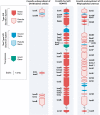Coxiella burnetii and Related Tick Endosymbionts Evolved from Pathogenic Ancestors
- PMID: 34009306
- PMCID: PMC8290121
- DOI: 10.1093/gbe/evab108
Coxiella burnetii and Related Tick Endosymbionts Evolved from Pathogenic Ancestors
Abstract
Both symbiotic and pathogenic bacteria in the family Coxiellaceae cause morbidity and mortality in humans and animals. For instance, Coxiella-like endosymbionts (CLEs) improve the reproductive success of ticks-a major disease vector, while Coxiella burnetii causes human Q fever, and uncharacterized coxiellae infect both animals and humans. To better understand the evolution of pathogenesis and symbiosis in this group of intracellular bacteria, we sequenced the genome of a CLE present in the soft tick Ornithodoros amblus (CLEOA) and compared it to the genomes of other bacteria in the order Legionellales. Our analyses confirmed that CLEOA is more closely related to C. burnetii, the human pathogen, than to CLEs in hard ticks, and showed that most clades of CLEs contain both endosymbionts and pathogens, indicating that several CLE lineages have evolved independently from pathogenic Coxiella. We also determined that the last common ancestorof CLEOA and C. burnetii was equipped to infect macrophages and that even though horizontal gene transfer (HGT) contributed significantly to the evolution of C. burnetii, most acquisition events occurred primarily in ancestors predating the CLEOA-C. burnetii divergence. These discoveries clarify the evolution of C. burnetii, which previously was assumed to have emerged when an avirulent tick endosymbiont recently gained virulence factors via HGT. Finally, we identified several metabolic pathways, including heme biosynthesis, that are likely critical to the intracellular growth of the human pathogen but not the tick symbiont, and show that the use of heme analog is a promising approach to controlling C. burnetii infections.
Keywords: Coxiella; endosymbiont; heme; pathogen; tick.
© The Author(s) 2021. Published by Oxford University Press on behalf of the Society for Molecular Biology and Evolution.
Figures






Similar articles
-
The Prevalence of Coxiella burnetii in Hard Ticks in Europe and Their Role in Q Fever Transmission Revisited-A Systematic Review.Front Vet Sci. 2021 Apr 26;8:655715. doi: 10.3389/fvets.2021.655715. eCollection 2021. Front Vet Sci. 2021. PMID: 33981744 Free PMC article.
-
The IS1111 insertion sequence used for detection of Coxiella burnetii is widespread in Coxiella-like endosymbionts of ticks.FEMS Microbiol Lett. 2015 Sep;362(17):fnv132. doi: 10.1093/femsle/fnv132. Epub 2015 Aug 12. FEMS Microbiol Lett. 2015. PMID: 26269380
-
Diversity of Coxiella-like and Francisella-like endosymbionts, and Rickettsia spp., Coxiella burnetii as pathogens in the tick populations of Slovakia, Central Europe.Ticks Tick Borne Dis. 2018 Jul;9(5):1207-1211. doi: 10.1016/j.ttbdis.2018.05.002. Epub 2018 May 3. Ticks Tick Borne Dis. 2018. PMID: 29748120
-
The Recent Evolution of a Maternally-Inherited Endosymbiont of Ticks Led to the Emergence of the Q Fever Pathogen, Coxiella burnetii.PLoS Pathog. 2015 May 15;11(5):e1004892. doi: 10.1371/journal.ppat.1004892. eCollection 2015 May. PLoS Pathog. 2015. PMID: 25978383 Free PMC article.
-
Prevalence of Coxiella-infections in ticks - review and meta-analysis.Ticks Tick Borne Dis. 2022 May;13(3):101926. doi: 10.1016/j.ttbdis.2022.101926. Epub 2022 Feb 16. Ticks Tick Borne Dis. 2022. PMID: 35190334 Review.
Cited by
-
Molecular Survey of Vector-Borne Pathogens in Ticks, Sheep Keds, and Domestic Animals from Ngawa, Southwest China.Pathogens. 2022 May 22;11(5):606. doi: 10.3390/pathogens11050606. Pathogens. 2022. PMID: 35631127 Free PMC article.
-
The Prevalence of Coxiella burnetii in Hard Ticks in Europe and Their Role in Q Fever Transmission Revisited-A Systematic Review.Front Vet Sci. 2021 Apr 26;8:655715. doi: 10.3389/fvets.2021.655715. eCollection 2021. Front Vet Sci. 2021. PMID: 33981744 Free PMC article.
-
Profiles of Microbial Community and Antibiotic Resistome in Wild Tick Species.mSystems. 2022 Aug 30;7(4):e0003722. doi: 10.1128/msystems.00037-22. Epub 2022 Aug 1. mSystems. 2022. PMID: 35913190 Free PMC article. Review.
-
Impact of endosymbionts on tick physiology and fitness.Parasitology. 2023 Sep;150(10):859-865. doi: 10.1017/S0031182023000793. Epub 2023 Aug 24. Parasitology. 2023. PMID: 37722758 Free PMC article. Review.
-
Molecular Detection and Genotyping of Coxiella-Like Endosymbionts in Ticks Collected from Animals and Vegetation in Zambia.Pathogens. 2021 Jun 21;10(6):779. doi: 10.3390/pathogens10060779. Pathogens. 2021. PMID: 34205691 Free PMC article.
References
-
- Albertsen M, et al. 2013. Genome sequences of rare, uncultured bacteria obtained by differential coverage binning of multiple metagenomes. Nat Biotechnol. 31(6):533–538. - PubMed
-
- Almeida AP, et al. 2012. Coxiella symbiont in the tick Ornithodoros rostratus (Acari: argasidae). Ticks Tick Borne Dis. 3(4):203–206. - PubMed
-
- Alneberg J, et al. 2014. Binning metagenomic contigs by coverage and composition. Nat Methods. 11(11):1144–1146. - PubMed
Publication types
MeSH terms
Grants and funding
LinkOut - more resources
Full Text Sources
Other Literature Sources

